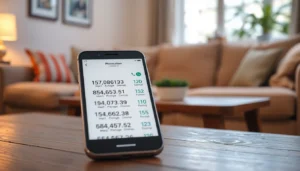Table of Contents
ToggleIn today’s fast-paced world, digital health monitors are transforming the way individuals manage their well-being. These innovative devices empower users to track vital health metrics, from heart rate and sleep patterns to blood pressure and activity levels, all from the convenience of their smartphones or wearables.
As technology continues to advance, the integration of digital health monitors into daily life is becoming increasingly essential. They not only promote awareness about personal health but also encourage proactive measures for better living. With a wealth of data at their fingertips, users can make informed decisions that lead to healthier lifestyles.
Overview of Digital Health Monitors
Digital health monitors serve as essential tools for tracking and managing individual health. These devices, including wearables and smartphone applications, collect real-time data on various health metrics. Users can monitor heart rate, sleep quality, blood pressure, and physical activity levels seamlessly.
These monitors typically utilize sensors to gather data and transmit it to connected devices. For example, smartwatches often include heart rate monitors that continuously track cardiovascular activity throughout the day. Sleep trackers can assess sleep duration and quality, assisting users in understanding their sleep patterns better.
The information obtained from digital health monitors encourages informed decision-making. Users can identify trends in their health metrics, enabling them to address concerns proactively. For instance, individuals noticing elevated blood pressure readings may consult healthcare professionals sooner rather than later.
Accessibility to this data enhances health awareness in a significant way. Continuous feedback motivates users to adopt healthier habits, like increasing physical activity or refining dietary choices. As digital health technologies advance, their role in fostering well-being becomes increasingly vital within everyday life.
Moreover, many digital health monitors integrate with other technologies, such as telehealth platforms. This connectivity allows healthcare providers to access patient data remotely, improving the quality of care. Enhanced communication between users and providers creates a collaborative approach to health management, ultimately driving better health outcomes.
Types of Digital Health Monitors

Digital health monitors come in various forms, enhancing the ability to track health metrics effectively. Two primary types are wearable devices and mobile applications.
Wearable Devices
Wearable devices include fitness trackers, smartwatches, and health monitoring bands. These devices typically measure heart rate, step count, calories burned, and sleep quality.
- Fitness Trackers: Fitness trackers automatically collect data on physical activity levels and provide feedback on user performance.
- Smartwatches: Smartwatches often include features like heart rate monitoring, GPS tracking, and notifications, integrating technology with health management.
- Health Monitoring Bands: Health monitoring bands focus on specialized metrics, such as blood oxygen levels and stress management.
These devices encourage users to maintain an active lifestyle while providing real-time insights into their health.
Mobile Applications
Mobile applications enhance health monitoring by allowing users to track metrics and analyze data on their smartphones.
- Health Tracking Apps: Health tracking apps allow users to log food intake, exercise, and vital signs, offering personalized insights.
- Sleep Monitoring Apps: Sleep monitoring apps analyze sleep patterns, providing users with alerts and recommendations for better rest.
- Telehealth Apps: Telehealth apps facilitate communication with healthcare providers, improving access to medical advice and treatment plans.
These applications offer flexibility for users to manage their health on-the-go, promoting continuous engagement with personal wellness.
Benefits of Using Digital Health Monitors
Digital health monitors provide numerous advantages for users striving to improve their health management. The ability to track health metrics in real-time significantly enhances overall well-being.
Improved Health Tracking
Improved health tracking facilitates comprehensive monitoring of vital metrics. Users can access data on heart rate, sleep quality, and activity levels at any time. Digital health monitors utilize advanced sensors to collect accurate information, empowering users to spot patterns and trends. For example, a fitness tracker may reveal consistent fluctuations in heart rate during workouts, helping users optimize their fitness routines. Furthermore, tracking these metrics leads to better understanding of individual health, enabling tailored approaches for each user’s specific needs.
Enhanced Patient Engagement
Enhanced patient engagement encourages active participation in personal health management. Digital health monitors provide users with actionable insights based on real-time data collection. By sharing this information with healthcare providers, patients foster meaningful discussions about treatment and preventive strategies. For instance, a user sharing blood pressure readings with a physician can lead to more informed decisions regarding lifestyle changes or medication adjustments. Additionally, reminders and prompts from these devices encourage users to adhere to medication schedules and recommended health practices, reinforcing the importance of consistent engagement with their health.
Challenges in Digital Health Monitoring
Digital health monitoring faces various challenges that can impact its effectiveness and user experience. Key issues include data privacy concerns and accessibility issues that affect a broad range of users.
Data Privacy Concerns
Data privacy remains a significant challenge in digital health monitoring. These devices collect sensitive personal health information, raising fears about unauthorized access and misuse. Users often worry about sharing data with third parties, such as advertisers or healthcare providers, which can lead to breaches of confidentiality. Legislation, such as the Health Insurance Portability and Accountability Act (HIPAA), provides some level of protection, yet compliance varies widely among developers. Trust in digital health monitors hinges on transparent data practices, secure storage solutions, and user control over personal information.
Accessibility Issues
Accessibility issues present another barrier to the effective use of digital health monitors. While many devices are designed for a broad audience, users with disabilities may encounter challenges in navigation and usability. Variability in internet access also affects engagement, particularly in rural areas or low-income communities where technology may be less available. Language barriers and differing levels of digital literacy can further hinder user participation. Ensuring that devices and applications are user-friendly and inclusive promotes broader adoption and maximizes health monitoring benefits for diverse populations.
The Future of Digital Health Monitors
The future of digital health monitors holds significant promise as technological advancements continue to shape healthcare. Innovations such as artificial intelligence and machine learning will enhance real-time data analysis, allowing for more personalized health insights. Users receive tailored recommendations based on historical data, improving their ability to manage chronic conditions and optimize wellness.
Widespread integration of digital health monitors into everyday life will likely occur through increased connectivity and interoperability. Devices are expected to connect seamlessly with various health platforms, facilitating the sharing of comprehensive health data among users, healthcare providers, and caregivers. This connectivity supports a holistic approach to health management, streamlining communication and enhancing patient care.
Regulatory frameworks surrounding digital health monitors will also evolve. Policymakers are anticipated to establish clearer guidelines to protect user data while promoting innovation in the health tech industry. These regulations will reinforce consumer trust and expand the adoption of digital health monitors across diverse populations.
Emerging technologies, such as biosensors and remote monitoring tools, will likely transform digital health monitoring further. These innovations enable continuous tracking of vital signs and health metrics, allowing for immediate intervention when necessary. Patients gain access to prolonged monitoring without frequent in-person visits, increasing adherence to treatment plans and improving health outcomes.
The potential for gamification in digital health monitors will enhance user engagement. Incorporating game-like elements, such as challenges and rewards, encourages individuals to maintain healthy behaviors consistently. This strategy fosters a sense of community, motivating users to share progress and support one another in achieving health goals.
As digital health monitors advance, their role in preventive care will grow. By identifying risk factors sooner, users can take proactive steps toward achieving optimal health. Greater accessibility and affordability will enhance the reach of these monitors, bridging gaps in healthcare for underserved communities and improving public health as a whole.
Digital health monitors are revolutionizing personal health management. By providing users with real-time insights into their health metrics they empower individuals to take charge of their well-being. The integration of these devices into everyday life not only promotes healthier habits but also enhances communication between users and healthcare providers.
As technology continues to advance the potential for digital health monitors will only expand. With innovations like artificial intelligence and improved data sharing users will benefit from even more personalized health insights. Addressing challenges such as data privacy and accessibility will be essential in ensuring these tools reach a wider audience. Ultimately digital health monitors represent a significant step toward a more proactive and informed approach to health care.







